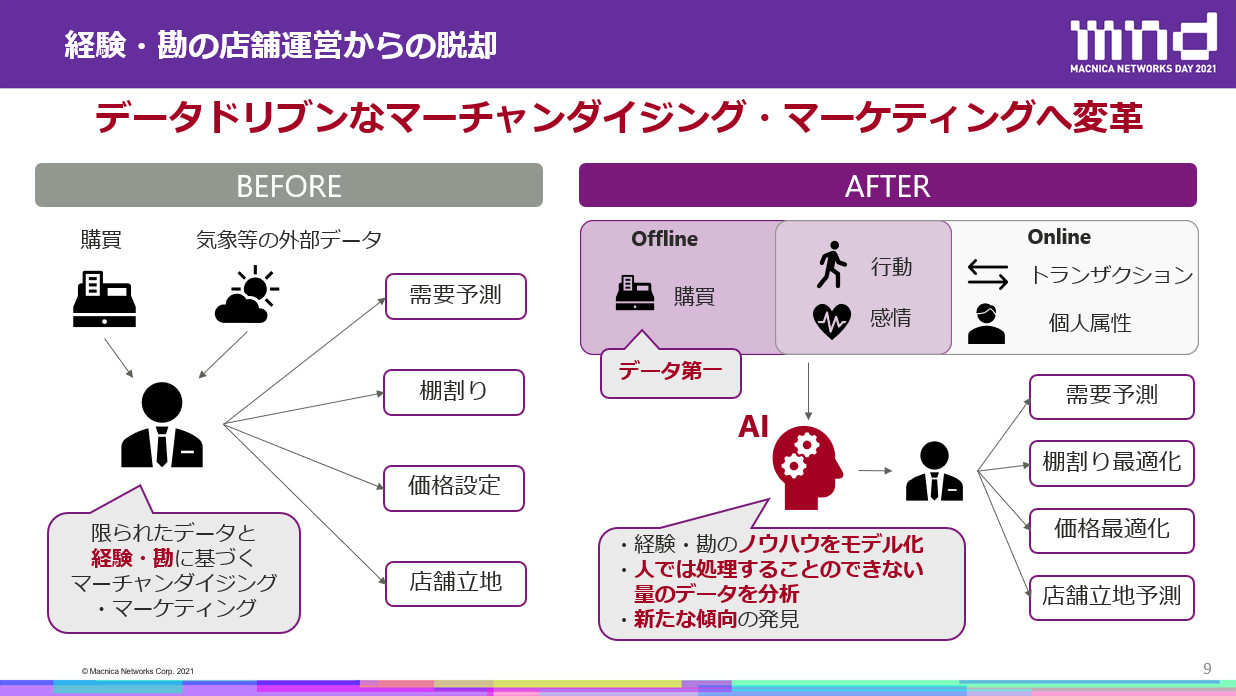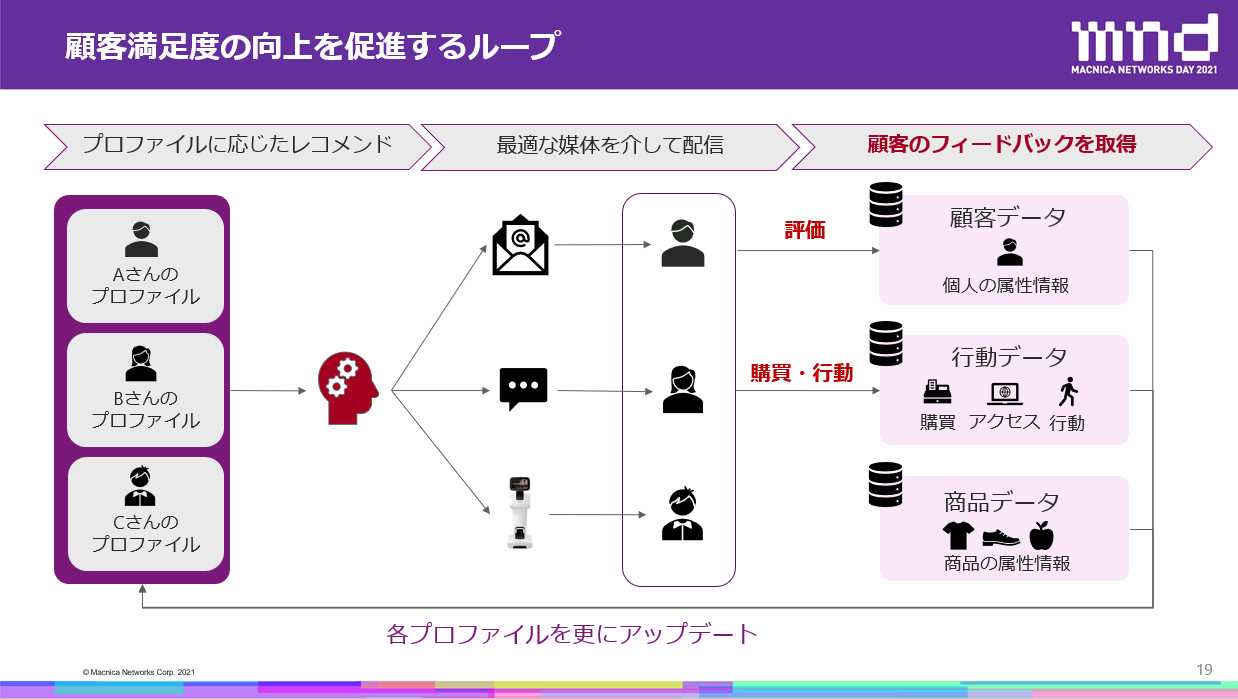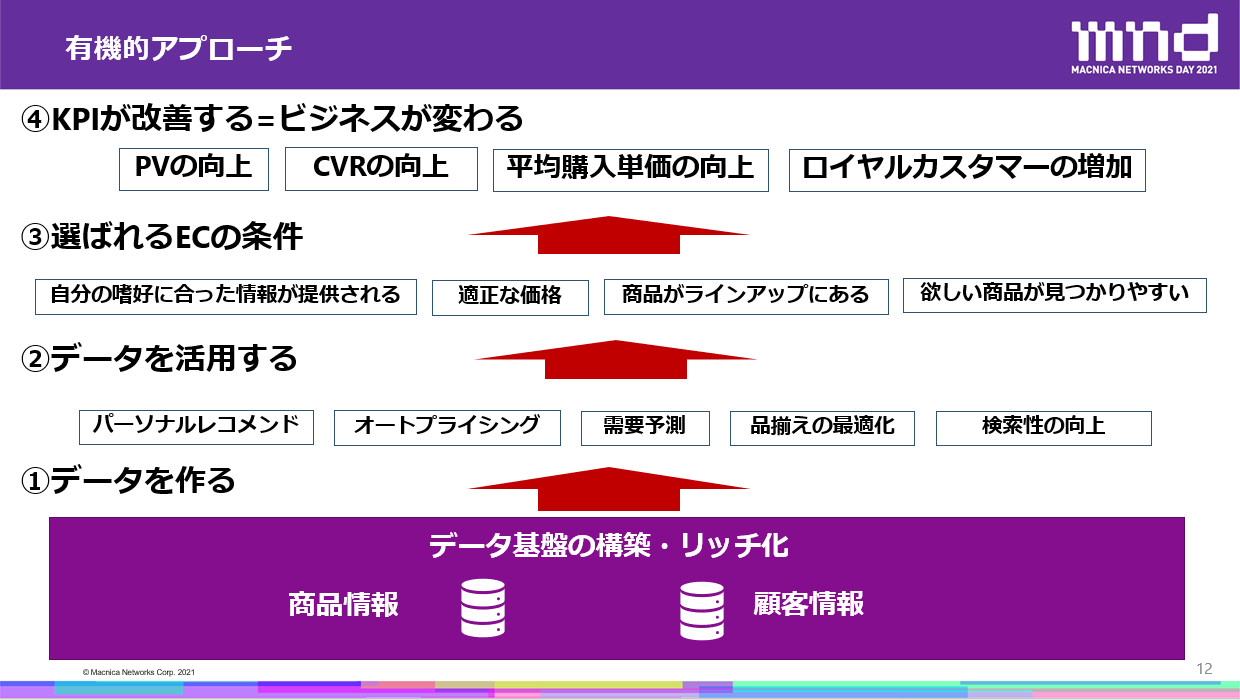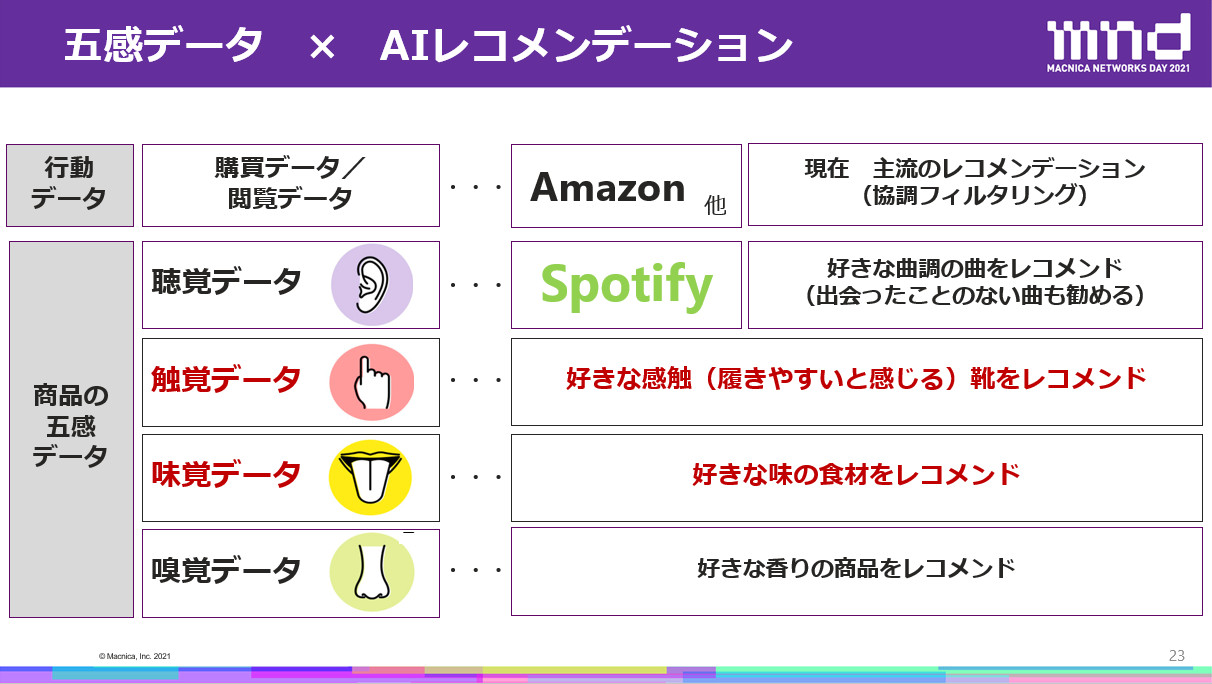
With the development of sensing technology, it has become possible to convert various phenomena into data. For example, by installing cameras and smart mirrors in a store, it is possible to convert customers' movements within the store and the time they spend on the sales floor into data, along with their facial expressions. Taking advantage of this, initiatives are underway for OMO (Online Merges with Offline), which provides the same recommendations and customer experience on both e-commerce sites and physical stores. AI accelerates these efforts with deep insights. Here, we will explain the OMO, AI, sensing technology, etc. that Macnica is working on.
[Speaker profile]
Macnica Network Co., Ltd.
In charge of DX Division AI Business Department Section 1
Haruki Sakata
Macnica Network Co., Ltd.
In charge of DX Division AI Business Department Section 1
Manami Ota
Macnica
Director of New Business Headquarters Project Promotion Office
Masayuki Hayashi
3 steps to increase loyal customers
As online purchasing continues to grow, brick-and-mortar stores also need to undergo digital transformation. So, what kind of mindset should they have and what measures should they take?
First, one way to solve the various issues facing brick-and-mortar stores is to increase the number of "royal customers." Loyal customers are different from "good customers" who continue to buy products. They are customers who have an attachment to a product or brand and recommend it to others. Haruki Sakata of the DX Division and AI Business Department at Macnica Network says the following:
"In order to increase the number of loyal customers, you need to take three steps: 'know your customers,' 'increase touchpoints with your customers,' and 'show favoritism to your customers.' Data-driven initiatives are already underway in the online domain, and will likely expand into the offline domain in the future. The key word here is 'OMO,' which combines online and offline." (Sakata)
To realize OMO, it is necessary to move away from store strategies based on experience and intuition and adopt merchandising and marketing strategies that put data first. Currently, as customer preferences and behavior are diversifying, systems are created to collect data and the collected data is analyzed to deepen understanding of customers, but by introducing AI into this process, it is possible to not only deepen the customer experience but also improve operational efficiency.

Achieving OMO through data-driven, breaking away from store management that relies on intuition and experience
Achieving OMO through data-driven store reform
There are six steps to achieving data-driven store reform. Of these, 1 to 3 will proceed on the desk.
1: Draw a customer journey that fuses online and offline
2: Define value proposition at each touchpoint with customers
3: Identify the data necessary to provide value
4: If you don't have the necessary data, get the data
5: Build a system to accumulate and analyze data
6: Leverage data and deliver personalized value with AI
"The important thing here is to 'obtain customer feedback' and 'update the content of AI recommendations' based on that feedback. Optimizing recommendations according to each customer's profile. After distributing it through various media, we will further update each customer's profile based on their evaluation and purchase behavior." (Sakata)

Customer profiles need to be constantly updated
AI analysis is the first step in measures to expand loyal customers
In fact, a certain retailer is implementing planogram recommendation measures for an unspecified number of customers. We accumulated data from cameras that monitored customer flow lines and product shelves, added various data, and analyzed it with an AI that was developed based on pre-definition of requirements. By arranging the product shelves based on the results, we created an opportunity for customers who casually visited the store to experience new encounters and discoveries, leading to purchasing behavior and becoming fans through differentiation.
"In this way, by integrating measures that were previously carried out separately online and offline, and implementing measures for each customer, such as knowing the customer, increasing the number of touch points, and promoting favoritism, the level of satisfaction of each customer will increase. The number of loyal customers will increase.To that end, the first step is to draw a customer journey and acquire data.The introduction of AI will lead to more efficient measures. can be done.” (Sakata)
Points and measures to become a “chosen e-commerce”
In recent years, the EC rate has been increasing for both BtoC and BtoB, and combined with the impact of the coronavirus pandemic, the market size is also rapidly growing. Along with this, the number of e-commerce users is increasing, and the categories of products they purchase are also changing. Furthermore, companies that only have physical stores are starting to expand into e-commerce. However, if these measures fail, even traditional loyal customers will leave. So, what does it take to become an EC of choice?
What consumers want from EC and the measures to address them are as follows (measures are in parentheses).
・Appropriate price (auto pricing)
・Delivery speed (process optimization)
・In stock (demand forecast)
・The products you want are on sale (product assortment)
・You can find the product you want (searchability)
・Be able to make purchasing decisions (quantity and quality of product information)
・Provides information on products that match your tastes and interest you (personal recommendations)
"The important data that should be used in e-commerce is product information and customer information. To utilize this information, it is important to organize and combine both product information and customer information. "It's easy to overlook things, but it's important to take an approach that works together organically while envisioning the overall connection and business impact, rather than thinking about them separately," says Manami Ota of Macnica Network's DX Division and AI Business Division. Masu.
In an organic approach, it is important to collect product information and customer information into structured data. This allows you to utilize that data for the first time.
“By achieving personal recommendations, auto-pricing, demand forecasting, optimizing product assortments, and improving searchability, we will become the EC of choice.This will improve PV, CVR, average purchase price, etc., and as a result, increase loyalty. This will lead to an increase in customers and improve KPIs, which will change the business.'' (Ota)

Image of “organic approach”
What is a solution that realizes an organic approach?
Various efforts are necessary to realize an organic approach. Taking "maintenance of product information" as an example, the data collected from various places has a wide variety of formats, so first we extract product attribute information from the data, estimate additional product information, then structure the data, It needs to be post-processed and output. By introducing AI there, data maintenance can be automated.
“Customer information is difficult to collect in the first place, and it is not always accompanied by sufficient attribute information.Using AI, we can extract customer DNA from past purchase data, search logs, responses to emails, etc. This allows us to analyze customer segments in detail, improve the accuracy of communication with customers, and lead to conversions." (Ohta)
In addition, as "optimization of site content for improved searchability", "recommendation of product name", "recommendation of product category", "recommendation of important attributes (filter items)", "automatic pricing", "product lineup There are optimization and demand forecasting, and these can also be done with AI.
One-to-one communication using AI
An example of recommendation using AI is an apparel business. The company understands customer preferences and provides "One to One Communication" tailored to those preferences. First, we create a "style image DB" by tagging the products we handle. User preferences were extracted using AI from application activity logs and stored in the "User Preferences DB."
By combining these two databases, we use recommendation AI to send various combinations of promotional emails to each customer, and by feeding back the results, we optimize proposals for each customer. As a result, we were able to maximize sales opportunities.
"By utilizing data with AI, we can realize an organic approach and solve various issues in e-commerce business. At Macnica, we have an AI company called CrowdANALYTIX, so we can take an organic approach. We can support any part of the throat, and we can also handle more advanced efforts.'' (Ota)
Mechanism and challenges of recommendation
Like the apparel company mentioned above, many current recommendations are based on "behavioral data" such as purchase data and browsing data. If we take a closer look at how these recommendations work, we can see that all information, such as the content of the websites that users have viewed and the products they have purchased, is stored as logs. AI processes this information to infer the products and content that each user is interested in, and displays the relevant items.
"If you dig deeper into AI processing, there are two major technologies: collaborative filtering and content-based filtering. These technologies seem very good, but they also present challenges, such as some customers feeling uncomfortable with excessive recommendations, and on the e-commerce side there is a huge gap between products that are selling and those that are not," says Hayashi Masayuki of the Project Promotion Office at Macnica New Business Division.
Giving new discoveries to customers with "five senses x AI recommendation"
One way to solve these problems is "five senses x AI recommendation". By incorporating data related to the five senses of "seeing", "listening", "eating", "smell" and "touching" into AI, it is possible to make recommendations that create new encounters.
"For example, Spotify, which provides the world's largest music distribution service, accumulates music listened to by users as an access log, but it also applies AI processing to audio waveform data of songs. Waveforms The data stores information such as the tempo, tune, and length of the song.
Spotify recommends songs that you haven't heard at all, so you can make new discoveries. It also recommends songs from different genres. Then you will feel like you know what you like better than yourself. New discoveries broaden my horizons, so I become a fan.” (Hayashi)

Utilize audio waveform data for recommendations
What is Macnica unique "Five Senses x AI Recommendation"?
Macnica is also working on the development of "Five Senses x AI Recommendation." Specifically, it is a recommendation that utilizes tactile and taste data. Tactile data is combined with shoes, taste data is combined with ingredients, dishes, etc. We also work on demand forecasting and writing.
“The value of five senses x AI recommendation is that it creates new discoveries, can respond to “slight” needs, and accumulates knowledge for the application.For example, it can recommend the appropriate product for a problem such as a slight pain in the tip of your toe. By doing so, you can create that data asset.This will promote enjoyment and improve LTV (lifetime value).In this way, the five senses x AI recommendation is the same as the current AI recommendation. It has the potential to solve the problems faced by people.'' (Hayashi)

Macnica 's initiative: "Five Senses x AI Recommendations"
▼Retail DX example
▼ Business problem-solving AI service that utilizes the data science resources of 25,000 people worldwide
Click here for details.Fully customized AI service CrowdANALYTIX
